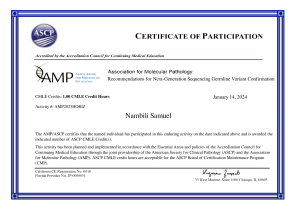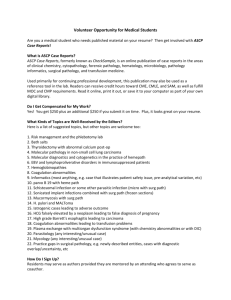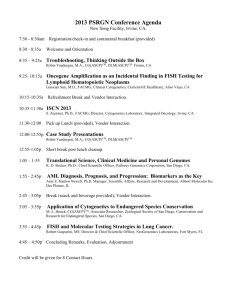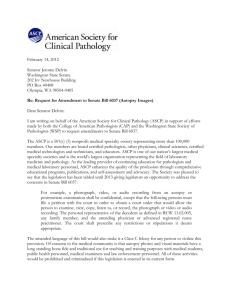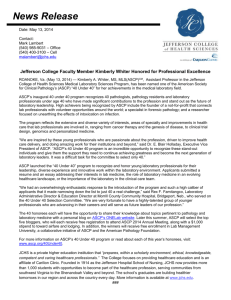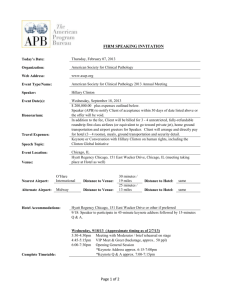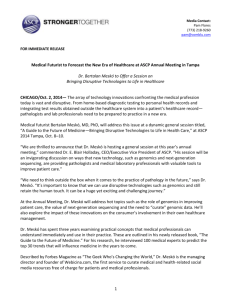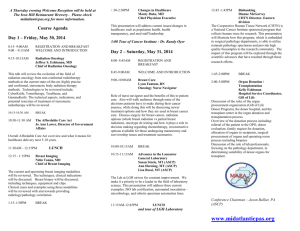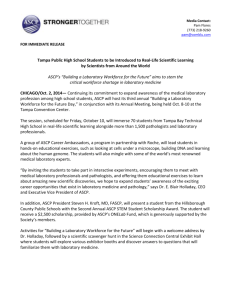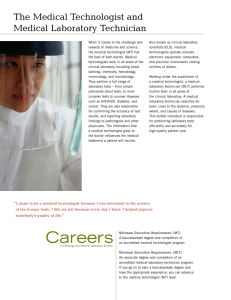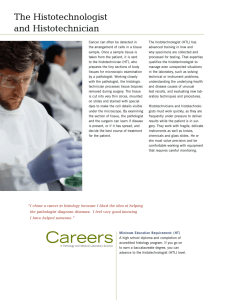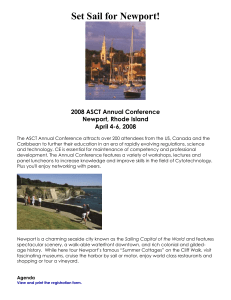Inaugural Address - American Society for Clinical Pathology
advertisement
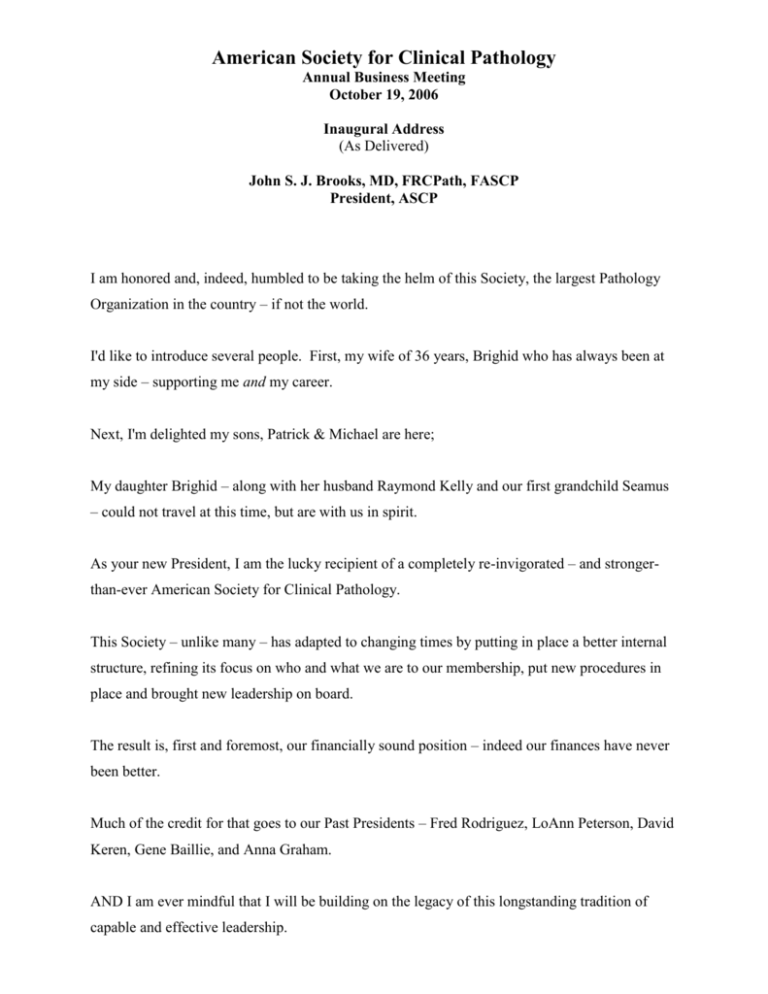
American Society for Clinical Pathology Annual Business Meeting October 19, 2006 Inaugural Address (As Delivered) John S. J. Brooks, MD, FRCPath, FASCP President, ASCP I am honored and, indeed, humbled to be taking the helm of this Society, the largest Pathology Organization in the country – if not the world. I'd like to introduce several people. First, my wife of 36 years, Brighid who has always been at my side – supporting me and my career. Next, I'm delighted my sons, Patrick & Michael are here; My daughter Brighid – along with her husband Raymond Kelly and our first grandchild Seamus – could not travel at this time, but are with us in spirit. As your new President, I am the lucky recipient of a completely re-invigorated – and strongerthan-ever American Society for Clinical Pathology. This Society – unlike many – has adapted to changing times by putting in place a better internal structure, refining its focus on who and what we are to our membership, put new procedures in place and brought new leadership on board. The result is, first and foremost, our financially sound position – indeed our finances have never been better. Much of the credit for that goes to our Past Presidents – Fred Rodriguez, LoAnn Peterson, David Keren, Gene Baillie, and Anna Graham. AND I am ever mindful that I will be building on the legacy of this longstanding tradition of capable and effective leadership. We are also blessed with an outstanding Executive Director John Ball, and the excellent staff at our headquarters in Chicago. As a result of their hard work, along with the Board of Directors and many, many dedicated volunteers, this Society is now looking forward, growing again, with more pathologist members than ever before, and 140,000 members in total. No other society can boast such full representation of the entire "Lab Team" That said, we can not rest on our laurels. The Future of Pathology and Laboratory Medicine is, frankly, not at all clear. There are major threats to the profession, but I view them as opportunities as well. To a great extent our future will be what we make it – but I’m confident that, come what may, the ASCP will be there for its members in both the short and long run. I’m comfortable saying that because we have a new Strategic Plan in place – one that examines the various elements affecting the profession, and we have used it to chart our course. Some of the future is, naturally, unknown. But much of it – thanks to the work of our strategic planning process – is clear. Technological advances are always before us, and now we are in the midst of the molecular and indeed, the post-genomics era. One of our most important tasks will be assisting our members in making the transition to technologies based on proteomics and metabolomics. Our members need to understand these new methods and master the new test environments and platforms. Since the beginning, we in the laboratory have imparted key information to clinicians and patients - the blood counts, chemistries, and biopsy diagnoses. The Future will hopefully see us in the Information Driver's Seat, synthesizing our lab data into more meaningful reports. We will be Information Managers, thus providing a new Service and making ourselves more valued members of the health care team, active members of that team. Patient Safety initiatives are already underway across the nation. We at the ASCP see this as an issue that can pull us into the mainstream of Health Care, by charting our Future course correctly. Pathologists and Laboratory Professionals are already masters of Standard Operating Procedures, Work Flow and Quality Processes, and our expertise in this area can enable us to lead our hospitals in systematizing the care process for the patient, reducing errors. Once again, the ASCP will be delivering products empowering our members to be leaders in Patient Safety. Globalization seems to be everywhere today, affecting every industry and ours is no exception. The ASCP has already taken this threat and turned it into an opportunity – we are now offering Certification to lab professionals in several countries, and supplying our Resident In-Service Exam to others. In Anatomic Pathology, we are all familiar with digital imaging of our microscopic slides. With a few more enhancements, these images can be sent around the world, and the patient diagnoses could be provided by practitioners in far off lands! What do we do to confront this potential new reality? Well, there are a great many facets and complexities to this – and the ASCP intends to provide further understanding and guidance to its members and the profession at large. As developments in Technology, Information Systems, and Globalization change WHAT we do, we will need to change WHO we are and HOW we are perceived. Our roles in the Health System can and should change. We need to escape from the stereotype of being a bit apart from patient care, of being in the background. Patient Care IS our business, everything we do is for the Patient. We work tirelessly, under incredible pressure, and with an envious record of quality. We care deeply for everyone of our patients. BUT we need to voice this more directly, and be actively involved. Becoming "Information Managers" will certainly help. The ASCP intends to support changes in our training programs for both Residents and Technoloogists – to supply them with the new skill sets they will need in management and communication to transform the profession into truly active and vital contributors to Patient Care. Only by being visible and active can we demonstrate more clearly that what we provide is a service, not mere lab tests. As we all know too well, the public has little idea of how laboratories operate or what laboratory professionals and pathologists do. Our clinical colleagues also lack a clear understanding and see only lab results – the numbers. Goodness knows, the average hospital business executive thinks everything we do can be done better and cheaper by a machine. And the government sees only tests and the dollars they pay for them. The result is the lab test is now being seen as a commodity which can be sold on the open market to the highest bidder. No one sees how we quality control the equipment, validate the reference ranges, and check and re-check and verify the results and interpret them in context. Indeed, the government now has an initiative called "competitive bidding" in which large laboratories, likely commercial, will win contracts for testing in whole regions. The lab test becomes a commodity in this scenario. This would bypass our whole system of hospital laboratories and – importantly – sever the relationship between the clinicians, the local laboratory, and the patient. This may have devastating effects on how our services are provided. We need to counter these misguided impressions with vim and vigor. We need to win the argument that we provide services, not a commodity. While there are many other issues facing us, this one is fundamental – The Image of Our Profession. How do we fix it? We do so by educating the public and through our Advocacy efforts. The ASCP will be drawing up a communications plan to help, but it will not be easy. Our Washington Office has had great successes over the years and we need to underscore its importance to our members and to the greater Pathology and Laboratory Medicine Community as well. We in the ASCP have tremendous leverage – WHO Better than the ASCP to lead the cause? We have our strength in numbers (our 140,000 members), our broad diversity of laboratorians, and our inclusive nature. Who better than us to channel our Laboratory Coalition to promote greater understanding of the important services we provide for the nation's patients? Indeed, who better than us to partner with others like hospital associations, and inform health care executives about our unique role in patient care? Better understanding of what we do will lead to increased respect from all quarters. I for one, representing you, intend take this strong message to as many different constituents as possible – talking to healthcare executives, talking in public forums and before Patient Advocacy groups. I'm a great believer in communication and by speaking out, hope to improve our image during my year as your President. I look forward to serving you – our members, who are really our constituents. We have a Plan for the Future and we are headed, I believe, where you want us to go. Please don't hesitate to contact me about any thoughts you may have on our priorities. Thank you for your confidence in me and I pledge to work as hard as I can to live up to your expectations.
